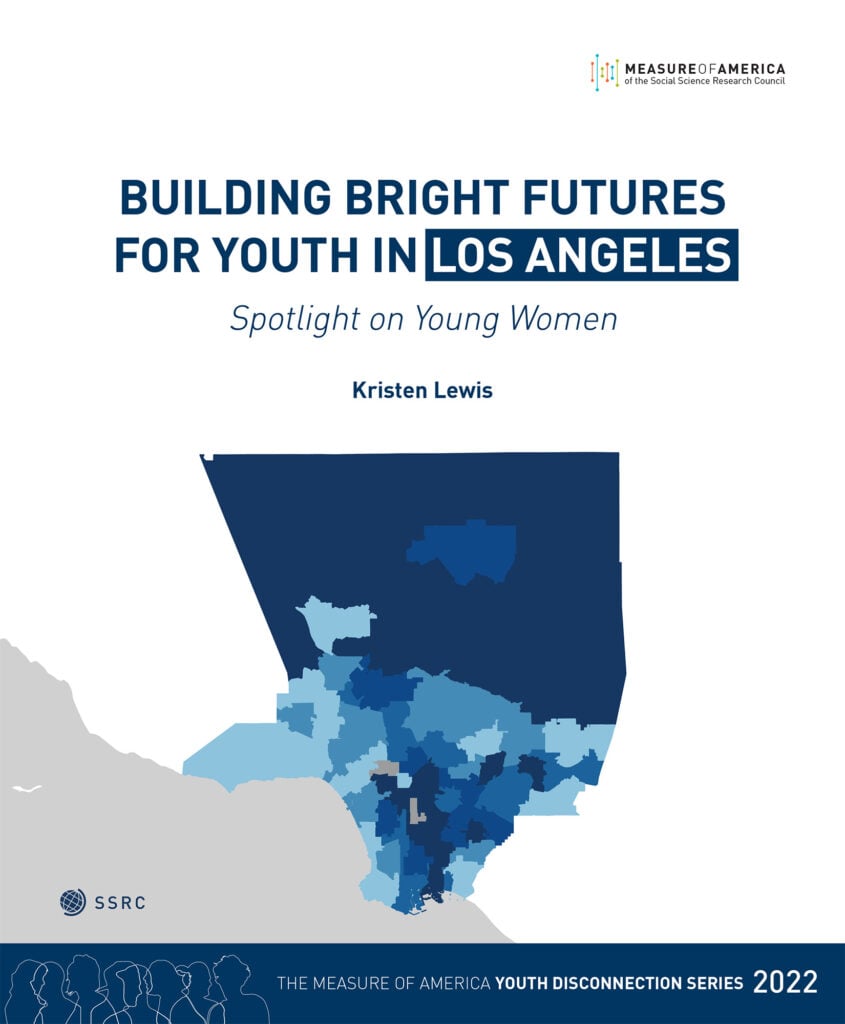Building Bright Futures for Youth in Los Angeles
LAUNCHED NOVEMBER 17, 2022
FULL REPORT | INTERACTIVE TOOL | LAUNCH WEBINAR
 Building Bright Futures for Youth in Los Angeles: Spotlight on Young Women provides an in-depth look at youth disconnection in Los Angeles County. The report presents 2020 youth disconnection rates for the County as a whole as well as by gender, race and ethnicity, and neighborhood cluster / public use microdata area (PUMA). The new report also has a special focus on young women—particularly young mothers—who Measure of America’s research shows face unique barriers to completing their education, building their careers, and accessing critical health care. The report contains exploration of issues related to youth disconnection in Los Angeles as well as conclusions and recommendations informed by collaboration with local stakeholders and an advisory group comprised of young adults in Los Angeles. The report also contains an overview of important multisectoral initiatives in this space.
Building Bright Futures for Youth in Los Angeles: Spotlight on Young Women provides an in-depth look at youth disconnection in Los Angeles County. The report presents 2020 youth disconnection rates for the County as a whole as well as by gender, race and ethnicity, and neighborhood cluster / public use microdata area (PUMA). The new report also has a special focus on young women—particularly young mothers—who Measure of America’s research shows face unique barriers to completing their education, building their careers, and accessing critical health care. The report contains exploration of issues related to youth disconnection in Los Angeles as well as conclusions and recommendations informed by collaboration with local stakeholders and an advisory group comprised of young adults in Los Angeles. The report also contains an overview of important multisectoral initiatives in this space.
Disconnected youth are young people between the ages of 16 and 24 who are neither working nor in school. Here in the United States, organizations that work with this population began to use the term “opportunity youth” as a more optimistic phrase “that calls attention to the opportunities these young people seek and that should be opened up for them.”
The youth disconnection rate in Los Angeles County in 2020 is 13.2 percent, or 156,200 young people. Los Angeles County has a higher disconnection rate than California as a whole, at 12.3 percent.
KEY FINDINGS:
Girls and young women in Los Angeles County are less likely to be disconnected than boys and young men, 10.5 percent versus 15.7 percent. The size of the gender gap varies by race and ethnicity, however.
- Black teens and young adults have the highest disconnection rate, 23.4 percent, or 19,000 young people. Black young people have the largest gender gap in the youth disconnection rate of any racial or ethnic group—15.1 percent for Black girls and young women, compared to double that, 31.1 percent, for their male counterparts.
- Latina girls and young women are much less likely than their male counterparts to be disconnected, 11.2 as compared to 17.1 percent. In a striking departure from the situation a decade ago, Latina girls and young women are now about as likely as white boys and young men to be out of school and work.
- Asian teens and young adults have the lowest disconnection rate, 6.0 percent, or 8,500 young Angelenos. Asian girls and young women have the lowest rate of any race/gender combination, 5.6 percent, and Asian boys and young men have the second-lowest rate, 6.5 percent.
- The disconnection rate for white teens and young adults is 10.8 percent, or 22,000 people. White boys and young men are more likely than their female counterparts to be disconnected, 11.7 percent compared to 9.9 percent.
- The decade between 2010 and 2019 saw a steady and heartening decrease in the youth disconnection rate in the Los Angeles metropolitan area, from 14.2 percent to 9.2 percent. Covid-19 reversed this trend, with the rate jumping to 12.4 percent in 2020.
KEY ISSUES DISCUSSED IN THE REPORT:
- Covid-19’s Impact on Young Los Angelenos
- Characteristics of Connected and Disconnected Youth in Los Angeles
- Youth Disconnection by Place
- Youth Disconnection over Time
- The National Context
- Limitations of the Data
ISSUES DISCUSSED AS PART OF THE SPOTLIGHT ON GIRLS AND YOUNG WOMEN
- Early Motherhood
- Domestic Responsibilities
- Occupational Segregation
- Wage Inequality
- Gender-based Violence
- School Discipline and Incarceration
The report is available in PDF form here.